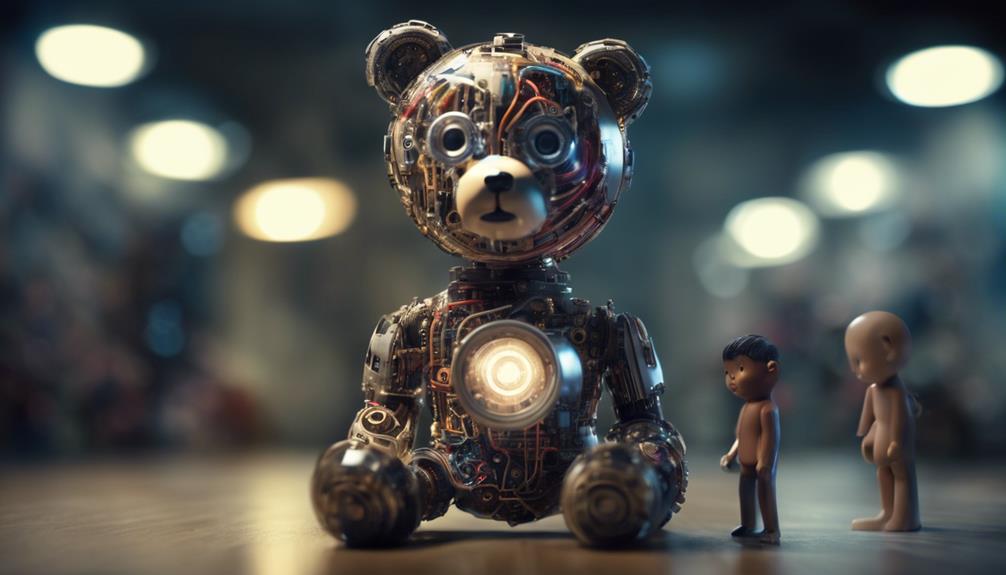AI-enhanced toys merge cutting-edge technology with potential educational advantages, offering personalized interactions that can significantly support a child's cognitive and emotional growth.
Yet, these innovative toys also introduce significant safety and privacy issues, including the risk of data breaches and the psychological effects on young users. Therefore, stringent regulatory measures and ethical standards must be enforced to ensure these toys do not endanger the well-being and security of children.
A thorough examination of both the benefits and risks highlights the challenges involved in maintaining a careful balance between advancing technology and protecting vulnerable users. Further research might reveal more about how to achieve this equilibrium.
Advantages of AI Toys
AI-enhanced toys offer several significant advantages, including the ability to adapt and personalise interactions, which can greatly enrich a child's play experience. These advanced toys utilise cutting-edge technology to learn from and respond to individual behavioural cues, creating a tailored experience that fosters deeper engagement and learning.
This adaptive interaction not only supports cognitive development by providing challenges that are in line with a child's growing abilities but also enhances emotional intelligence by responding to the child's emotional states. Additionally, such toys can serve as tools for behaviour modification, subtly encouraging positive social behaviours and discouraging negative ones.
As a result, AI-enhanced toys represent a powerful tool for influential learning and development, positioning them as a valuable asset in modern educational strategies.
Eilik: A Case Study
Building on the general benefits of artificial intelligence toys, Eilik provides a specific example of how these technologies are implemented in real-life scenarios to enhance interaction and learning.
With its advanced servo motors and dynamic animations, Eilik showcases a high degree of mechanical sophistication, enabling a variety of expressions that mimic lifelike interactions.
This AI-powered toy not only responds to a child's behavioural cues but also updates its functionalities through cross-platform software, ensuring continuous improvement and relevance.
The integration of such technology into a child's daily play environment highlights the potential of artificial intelligence to significantly enhance educational experiences.
Eilik's design emphasises meticulous attention to the safety and developmental advantages that artificial intelligence can provide in interactive toys.
Risks of AI Toys

While AI toys offer numerous developmental advantages, they also present significant risks concerning privacy, psychological impact, and data security.
The integration of AI into toys requires constant connectivity, often through the internet, which exposes children's daily activities to potential security breaches. This connectivity can inadvertently allow sensitive information to become accessible to unauthorised parties.
Psychologically, the anthropomorphic behaviours exhibited by AI toys might lead children to misunderstand the differences between animate and inanimate objects, potentially distorting their social and emotional development.
Moreover, the data these toys collect to personalise experiences can, if not rigorously protected, be exploited to influence child behaviour, subtly yet profoundly embedding biases or commercial motives.
Each of these aspects requires careful scrutiny to ensure the welfare of children.
Regulatory Considerations
Regulatory frameworks must be established to oversee the integration of artificial intelligence in children's toys, ensuring safety and protecting young users from potential harms. As artificial intelligence technology becomes more widespread, the need for rigorous oversight intensifies. Authorities must set clear guidelines that govern the design, functionality, and data management practices of AI-enhanced toys.
This includes thorough testing protocols to assess safety and the creation of standards to prevent data breaches and safeguard privacy. Additionally, continuous monitoring mechanisms should be implemented to adapt to evolving technologies and emerging risks. Regulatory bodies should equip themselves with the power to enforce compliance and penalise breaches, thereby ensuring that manufacturers prioritise the well-being of end-users over commercial gains.
Ethical Concerns

Exploring the ethical concerns of artificial intelligence in toys uncovers significant challenges in safeguarding children's privacy and overseeing their emotional development.
The incorporation of artificial intelligence within toys initiates a vital discussion on the potential for these devices to subtly influence a child's psychological landscape. Children, owing to their developmental stage, may not recognise the artificial nature of their interactions, potentially leading to distorted social perceptions.
Moreover, the collection and analysis of children's data through these toys, aimed at refining and personalising interactions, poses a serious risk to privacy, making it essential to implement stringent data protection measures.
The ability to affect the next generation's cognitive and emotional growth through artificial intelligence toys carries with it a profound responsibility to prioritise ethical standards and robust safeguards.
Conclusion
In conclusion, whilst AI-enhanced toys provide substantial advancements in interactive and educational experiences for children, they also pose considerable challenges related to privacy, security, and ethical concerns.
It is crucial for the continued development in this area to prioritise stringent regulatory frameworks and robust security measures to safeguard young users.
Striking a balance between innovation and these protective measures is essential to ensure that the integration of AI into children's toys delivers developmental benefits without compromising their safety and well-being.